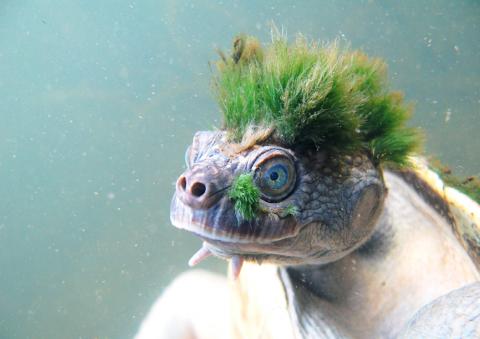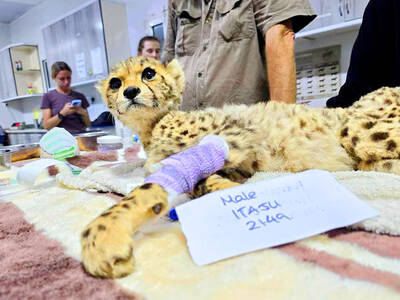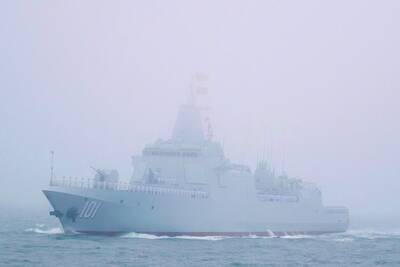It was “the punk turtle” — an eccentric and yet strangely human-looking reptile with a vivid green mohican, fleshy “fingers” under its chin and the ability to breathe through its genitals.
The Mary River turtle went viral in April, when pictures of the hitherto little-known creature were shared around the world after it was placed 30th on the Zoological Society of London’s Evolutionarily Distinct and Globally Endangered list for reptiles.
The rating, which guides conservation priorities for at-risk species, was compiled by Rikki Gumbs, who said that turtle fascination “went absolutely crazy” after its publication, as he fielded calls from journalists around the world.

Photo: Chris Van Wyk/Zoological Society of London
Reptiles are often overlooked, but the connection many felt for the animal does not surprise Gumbs.
“It’s the least these amazing reptiles deserve,” he said. “Once people can see how incredible and unique they are, it’s not surprising they are drawn to them.”
The turtle became endangered because it was widely collected for the pet trade in the 1960s and ’70s. Such collecting is outlawed now, but the turtle faces a new threat.
It is only found on a relatively small part of the Mary River in Queensland, Australia, and is imperiled by the loss and degradation of its habitat. Non-native plants prevent it laying eggs in sandy river banks; non-native foxes and dogs predate it.
When the turtle became famous, T-shirts were printed and sold, and Melbourne’s punk music scene held a concert to raise funds.
A crowdfunder has raised more than A$15,000 (US$10,762) to help conserve the species and its habitat. Peak turtle frenzy was reached when Cate Blanchett voiced a Mary River turtle puppet in a campaign video by the Wilderness Society to save “ugly” animals.
“That was pretty good and quite surreal,” Gumbs said.
He welcomes the Hollywood treatment for such “underdog species,” but the punk turtle’s surge into the spotlight has not substantially changed its fortunes.
“Despite all of this great media attention, there’s been no real action from the Australian government to change anything yet, which is a real shame,” he said.
There is no formal protection for any reptiles in Australia and no “species recovery plan” for the turtle, despite the Australian government first-drafting a river-based recovery plan for species, including the Mary River turtle in 2013.
Although the then-Labor government allocated A$2.4 million over six years to improve the health of the Mary River, the plan has not been enacted.
According to one local environment charity, it would only cost A$40,000 a year to save the turtle.
Gumbs points out that other species, such as Australia’s western swamp turtle, are also endangered.
For all the great publicity, he said: “Reptiles are still completely overlooked.”

ELECTION DISTRACTION? When attention shifted away from the fight against the militants to politics, losses and setbacks in the battlefield increased, an analyst said Recent clashes in Somalia’s semi-autonomous Jubaland region are alarming experts, exposing cracks in the country’s federal system and creating an opening for militant group al-Shabaab to gain ground. Following years of conflict, Somalia is a loose federation of five semi-autonomous member states — Puntland, Jubaland, Galmudug, Hirshabelle and South West — that maintain often fractious relations with the central government in the capital, Mogadishu. However, ahead of elections next year, Somalia has sought to assert control over its member states, which security analysts said has created gaps for al-Shabaab infiltration. Last week, two Somalian soldiers were killed in clashes between pro-government forces and

Ten cheetah cubs held in captivity since birth and destined for international wildlife trade markets have been rescued in Somaliland, a breakaway region of Somalia. They were all in stable condition despite all of them having been undernourished and limping due to being tied in captivity for months, said Laurie Marker, founder of the Cheetah Conservation Fund, which is caring for the cubs. One eight-month-old cub was unable to walk after been tied up for six months, while a five-month-old was “very malnourished [a bag of bones], with sores all over her body and full of botfly maggots which are under the

BRUSHED OFF: An ambassador to Australia previously said that Beijing does not see a reason to apologize for its naval exercises and military maneuvers in international areas China set off alarm bells in New Zealand when it dispatched powerful warships on unprecedented missions in the South Pacific without explanation, military documents showed. Beijing has spent years expanding its reach in the southern Pacific Ocean, courting island nations with new hospitals, freshly paved roads and generous offers of climate aid. However, these diplomatic efforts have increasingly been accompanied by more overt displays of military power. Three Chinese warships sailed the Tasman Sea between Australia and New Zealand in February, the first time such a task group had been sighted in those waters. “We have never seen vessels with this capability

‘NO INTEGRITY’: The chief judge expressed concern over how the sentence would be perceived given that military detention is believed to be easier than civilian prison A military court yesterday sentenced a New Zealand soldier to two years’ detention for attempting to spy for a foreign power. The soldier, whose name has been suppressed, admitted to attempted espionage, accessing a computer system for a dishonest purpose and knowingly possessing an objectionable publication. He was ordered into military detention at Burnham Military Camp near Christchurch and would be dismissed from the New Zealand Defence Force at the end of his sentence. His admission and its acceptance by the court marked the first spying conviction in New Zealand’s history. The soldier would be paid at half his previous rate until his dismissal